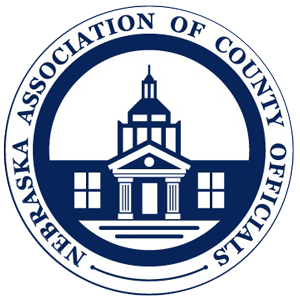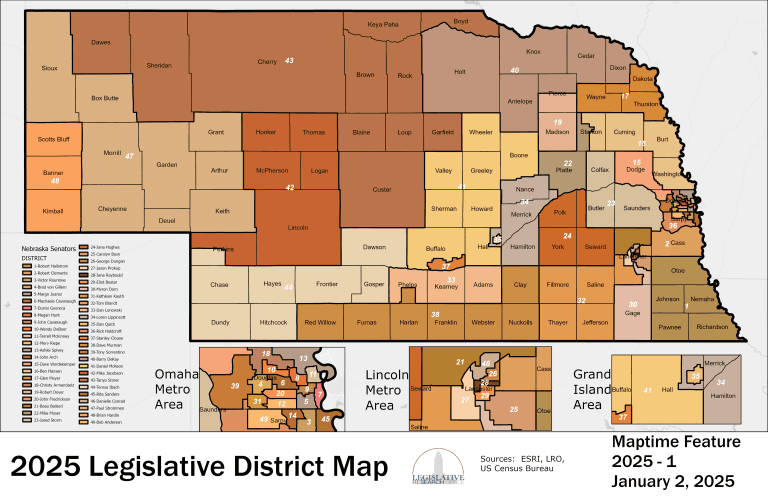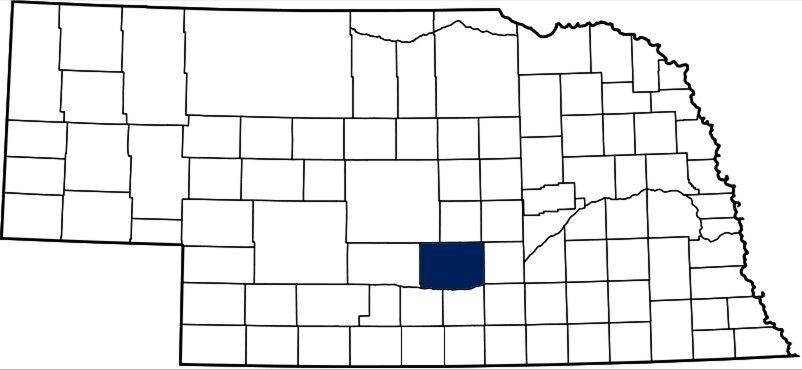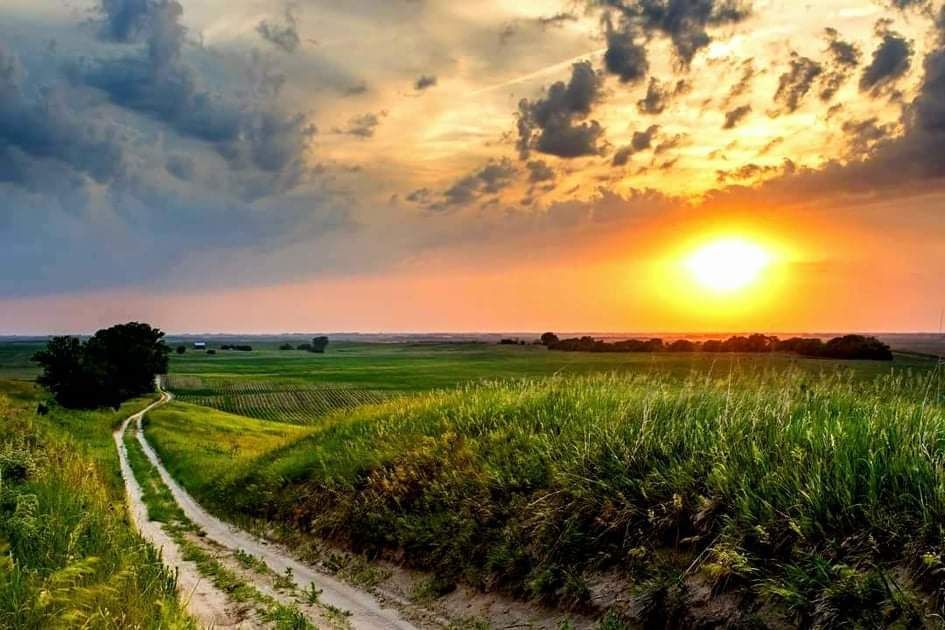- General Info
- Demographics
- Education and Employment
- Valuation and Taxes Levied
- State Senators
- History
- County Programs
- Other Information
Communities & Development
Buffalo County Seat: Kearney
Total County Population: 50,084
- Cities (pop.): Gibbon (1,878 • 2nd Class), Kearney (33,790 • 1st Class), Ravenna (1,441 • 2nd Class)
- Villages (pop.): Amherst (201), Elm Creek (979), Miller (129), Pleasanton (361), Riverdale (247), Shelton (1,034)
- Unincorporated Pop. (% of county pop.): 10,024 (20%) 2020
Land Development (% of total land in county):
- Agriculture: 86%
- By method: Irrigated (row crop/grain/forage) (42%); Pasture (pure grassland) (35%); Dryland (row crop/grain/forage) (9%) • Neb. Dept. of Rev. - total equals agriculture's %
- By commodity: Livestock (grassland) 35%, Corn 34%, Soybeans 15%, Alfalfa 3%, Sorghum 1% • USDA (NLCD) - equals agriculture's % plus some wetlands (5%) and some wooded grazing land (1%) and minus public grassland/wetlands and reserve
- Residential, Commercial, Industrial, Conservation Reserve & Exempt (combined): 12%
- Timber: 2% 2022
County Offices
Courthouse Address and Hours:
1512 Central Avenue
Kearney, Nebraska 68848
M-F 8:00 am - 5:00 pm
County Board Chairperson: Ivan Klein
Complete list of county board members
County Board Meetings: 2nd & 4th Tuesday
View the County's Government Maps
NACO District: Central
General
Population: 50,084
Land area (sq. mi.): 968.22
Population per square mile: 52.0
Race
Race 2020
White: 84.1%
African American: 1.2%
American Indian: 0.3%
Asian: 1.3%
Hispanic: 10.1%
Native Hawaiian and Pacific Islander: 0.1%
Two or More Races: 2.8%
Age 2020
0-17: 23.0%
18-64: 61.2%
65+: 15.8%
Households
Total households: 19,590 2020
With one child: 2,440 2022
With 2+ children: 3,470 2022
With seniors (65+): 4,380 2022
Socioeconomics
Median household income: $74,570 2023
% of population in poverty: 13.0% 2023
# of housing units: 20,947 2020
Owner-occupied rate: 63% 2020
Median home price: $256,150 Q4 2024
2024 building permits for detached single family homes: 118
2024 building permits for non-detached housing units: 7 (townhouse, duplex, or apt. unit)
Technology
Access to broadband (100 Mbps via fiber or cable model): 87.1% 2021
Sources: National Association of Realtors, Nebraska Department of Revenue, Nebraska Legislature, Nebraska Library Commission, U.S. Bureau of Economic Analysis, U.S. Census Bureau (building permits), U.S. Census Bureau (demographics), U.S. Census Bureau (municipalities)
Employment, Schools, and Child Care
Unemployment rate: 2.0% March 2025
County Employment Website: https://nebraskacounties.org/nebraska-counties/county-employment-opportunities.html
High school graduate or higher: 95.5% 2020
School Districts: Amherst Public Schools, Ansley Public Schools, Centura Public Schools, Elm Creek Public Schools, Gibbon Public Schools, Kearney Public Schools, Pleasanton Public Schools, Ravenna Public Schools, Shelton Public Schools, Sumner-Eddyville-Miller Schools
Bachelor's degree or higher: 24.2% 2020
Community College Service Area: Central Community College
Countywide child care capacity: 105 providers; 4,053 children 2024
Find child care: For a list of child care providers in your zip code, visit Nebraska DHHS or the Nebraska Resource and Referral System.
Buffalo County Economy
Annual Gross Domestic Product (GDP): $4,610,888 2023
Nonfarm Small Business Receipts: $1,275,393,571 2022
Nonfarm Wage Income: $1,222,001 2022
Farm and Ranch Commodity Sales Receipts: $527,052,00 2022
Farm and Ranch Operations (Non-Sales) Receipts: $36,047,000 2022
- For components of nonfarm small business receipts, nonfarm wage income, and farm & ranch commodity sales and operations receipts, see "Notes" below.
Grain Elevators by Location (bushels capacity):
- Elm Creek: CHS (3,684,000), KAAPA Ethanol (7,511,000)
- Gibbon: Cargill West (8,528,000)
- Kearney: The Andersons (565,413), Viterra (3,942,000)
- Riverdale: The Andersons (2,598,430), Viterra (2,832,000)
- (1 bushel = 56 lbs. corn/sorghum, 60 lbs. soybeans/wheat; % max. moisture = 18% beans, 15.5% corn, 14% sorghum/soybeans, 13.5% wheat)
Railroad Miles: 158.20 main, 29.92 side
- Places with Railroad Service: Buda, Elm Creek, Gibbon, Kearney, Odessa, Ravenna, Shelton
Local Grain Market: Click for today's grain prices in Buffalo County
Cattle Producers: 468
- Pastureland Cash Rent (avg.): $42/acre/yr 2024
Crop Producers: 491
- Dryland Land Cash Rent (avg.): $137/acre/yr 2024
Dairy Producers: 2
Ethanol Plants (annual production capacity): KAAPA Ethanol (130 million gallons)
Farmers Markets:
- Fairgrounds Farmers Market (June - October, Wednesdays 3 - 7 p.m. and Saturdays 8 a.m. - 1 p.m.)
- Kearney Area Farmers Market - Hilltop Mall (May - October, Wednesdays 2 pm to 6 pm and Saturdays 8 a.m. to 1 p.m.)
- Kearney Night Market (Every First and Third Thursday from April 6th, 2017 until October 5th, 7:00 p.m. – 10:00 p.m.)
- Ravenna Farmers Market (June - October, 4 - 7 p.m. on the 1st Friday of each month at 5 - 9 p.m.)
Electricity Providers: Custer PPD, Dawson PPD, Nebraska PPD, Southern PPD
Notes
- Nonfarm small business receipts are reported by partnerships and sole proprietorships. They do not include receipts reported by cooperative associations.
- Nonfarm wage income is reported based upon the wage earner's residential address; therefore, it also includes wages earned by Buffalo County residents in other counties or states, but it excludes wages earned in Buffalo County by residents of other counties or states.
- Nonfarm wage income excludes wages earned by anyone claimed as a dependent.
- Farm and ranch commodity sales receipts and operations receipts are reported based upon the farm or ranch owner's principal county of operations; therefore, those figures also include receipts reported by producers operating principally in Buffalo County for their production in other counties or states, but the figures exclude receipts reported for production in Buffalo County by producers operating principally in other counties or states.
Irrigation, Drinking Water, and Soils
Rural Irrigation/Livestock Wells: 3,790 2024
Rural Commercial/Industrial Wells: 40 2024
Rural Drinking Water Wells: 1,850 2024
Drinking Water Utility Connections: 12,039 Residential; 1,932 Commercial; 6 Industrial 2024
Irrigation/Livestock Wells per Square Mile: 3.91 2024
Surface Water Diversions (Irrigation): 91 2024
Click for real time:
Stream data on Elm Creek near the Village of Elm Creek
Stream data on the Platte River near Kearney
Stream data on the South Loup River at Saint Michael
Groundwater level data at Saint Michael
Groundwater level data near Kearney High School
Sources: National Agricultural Statistics Service (USDA), Nebraska Cooperative Council, Nebraska Coordinating Commission for Postsecondary Education, Nebraska Department of Health and Human Services, Nebraska Department of Revenue, Nebraska Department of Transportation, Nebraska Office of the CIO, Nebraska Power Review Board, Nebraska Public Service Commission, U.S. Bureau of Economic Analysis, U.S. Bureau of Labor Statistics, U.S. Census Bureau, U.S. Energy Information Administration, U.S. Department of the Treasury (IRS), Warehouse and Commodity Management Division (USDA)
2024 Levies and Valuations
County levy rate: $0.3355 per $100 of taxable valuation
County property taxes levied: $26,354,469
Total local government property taxes levied: $126,500,968
Total countywide taxable valuation: $7,855,766,173
Click here for all levy rates in Buffalo County
County Levy and Taxation Laws
Levy limits
Since 1996, counties and other political subdivisions have been subject to the levy limits listed in Neb. Rev. Stat. § 77-3442 and Neb. Rev. Stat. § 77-3443.
Statutes and regulations
Nebraska Revised Statutes (Chapter 77)
Nebraska Administrative Code (Title 350)
Local tax reductions, exemptions, and credits:
Neb. Rev. Stat. § 76-902(5)(a) (Deed "stamp tax" exemption): "The [stamp tax] shall not apply to: ... (5)(a) Deeds between spouses, between ex-spouses for the purpose of conveying any rights to property acquired or held during the marriage, or between parent and child, without actual consideration therefor."
Neb. Rev. Stat. § 77-201(2) (Valuation of agricultural land and horticultural land): "Agricultural land and horticultural land as defined in section 77-1359 shall constitute a separate and distinct class of property for purposes of property taxation, shall be subject to taxation, unless expressly exempt from taxation, and shall be valued at seventy-five percent of its actual value, except that for school district taxes levied to pay the principal and interest on bonds that are approved by a vote of the people on or after January 1, 2022, such land shall be valued at fifty percent of its actual value."
Neb. Rev. Stat. § 77-6703(1) (Tax credit for school district taxes paid): "(1) For taxable years beginning or deemed to begin on or after January 1, 2020, under the Internal Revenue Code of 1986, as amended, there shall be allowed to each eligible taxpayer a refundable credit against the income tax imposed by the Nebraska Revenue Act of 1967 or against the franchise tax imposed by sections 77-3801 to 77-3807. The credit shall be equal to the credit percentage for the taxable year, as set by the department under subsection (2) of this section, multiplied by the amount of school district taxes paid by the eligible taxpayer during such taxable year."
Sources: Nebraska Department of Revenue
State Senator: Daniel D. McKeon (District 41)
Committees: Agriculture; Business and Labor; Government, Military and Veterans Affairs; Building Maintenance
Map and statistics for Legislative District 41
State Senator: Stanley Clouse (District 37)
Committees: General Affairs; Natural Resources; Urban Affairs; Streamlined Sales and Use Tax System; Rural Broadband Task Force
Map and statistics for Legislative District 37
Map of all districts in the Nebraska Unicameral Legislature
Buffalo County History
Number of Registered Historic Places: 21
Year Authorized: 1855
Year Organized: 1870
Etymology: The American Bison
Buffalo County was established in 1855 and named after the American Bison which once dominated the landscape. Prior to the arrival of white settlers, Buffalo County was fertile hunting ground claimed by both Pawnee and Sioux Native American tribes. The first settlers in Buffalo County were Mormons whose early settlement became a stopover for emigrants headed to Utah and Oregon. In 1848, due to westward migration, Fort Kearny was constructed as a formal way station, offering shelter, supplies, and protection in the form of soldiers and a fortified structure. Although the county initially consisted of a few homesteads and small communities, it quickly grew as settlers from the east and other parts of the country arrived in search of new opportunities.
The first wave of settlers consisted primarily of farmers, ranchers, and traders. These early settlers were drawn to the area by the fertile soil, abundant water resources, and rolling prairies that were ideal for farming and livestock grazing. The arrival of the railroad in the 1870s further fueled the growth of the county, making it easier for settlers to move in and for crops and livestock to be transported to markets.
Buffalo County played an important role in Nebraska’s early development. During the late 1800s and early 1900s, the county was a major center of commerce and industry, with thriving agricultural and livestock industries, as well as manufacturing and transportation businesses. In addition, Buffalo County was a major player in the state's political and cultural development, with several influential politicians and cultural leaders hailing from the area. The county also played a key role in the nation's military history. During World War II, the area was home to several Army training centers, where thousands of soldiers were trained for service in Europe and the Pacific
Today, Buffalo County is a vibrant and thriving community, with a rich history and a bright future. The county is home to a diverse population, including families, students, business owners, and farmers, as well as the University of Nebraska - Kearney. The area's strong agricultural and economic base, combined with its close proximity to the cities of Kearney and Grand Island, make it one of the fastest growing areas in Nebraska.
Highlight an important program in your county in this space! Send an email to:
Local Highlights
License Plate Number: 9
Time Zone: Central
Zoned County: Yes
Number of Veterans: 2,644 2024
Number of County-Owned Bridges: 328
Number of County-Owned Dams: 4
Election Data
General Election Turnout: 77% 2024
Total Registered Voters: 31,434 2024
Number of Precincts: 29 2022
Number of Election Day Polling Places: 24 2022
Land Area per Polling Place: 40.64 sq. miles
Intergovernmental Data
Emergency Mgt. Planning, Exercise and Training (PET) Region: South Central
Natural Resource Districts: Central Platte NRD, Lower Loup NRD
State Lands (acres): Bassway Strip WMA (915), Blue Hole WMA (275.57), Bufflehead WMA (22.74), Coot Shallows WMA (43.35), East Odessa WMA (131.43), Fort Kearney SRA (186.18 Buffalo & Kearney), Kea Lake WMA (28.38), Kea West WMA (11.04), Kearney Rest Area EB (23.5), Kearney Rest Area WB (22.3), Sandy Channel SRA (180.57), Union Pacific SRA (37.95), War Axe SRA (25.07), University of Nebraska-Kearney (515), Windmill SRA (167)
Sources: Nebraska Department of Transportation, Nebraska Emergency Management Agency, Nebraska Game & Parks Commission, Nebraska Legislature, Nebraska Office of the CIO, Nebraska Secretary of State, U.S. Department of Veterans Affairs, U.S. Election Assistance Commission, U.S. National Archives and Records Administration (eCFR)



